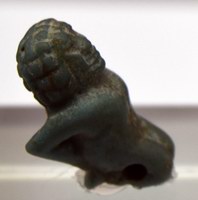Indice dei Musei
presenti in miti3000
Napoli Museo Nazionale - Piano -1 - Sala XXI La Mummificazione
- Intro sala XIX
- Sala XIX
- Intro sala XX
- Sala XX
- Intro sala XXI
- Sala XXI vetrina 49
- Sala XXI vetrina 50
- Sala XXI vetrina 51
- Sala XXI vetrina 52
- Sala XXI vetrina 53-54
- Sala XXI vetrine 55-56
- Sala XXI vetrine 57 - 58
- Sala XXI vetrine 60 - 61
- Sala XXI vetrine 62 - 63
- Intro Sala XXII
- Sala XXII vetrine 70 - 78
- Sala XXII vetrine 79 - 84
- Intro Sala XXIII
- Sala XXIII v.87-92
- Sala XXIII v.93-97
- Sala XXIII v.98-104
Testo
Sala XXI La Mummificazione vetrine 57 - 58
 Gebauy
Gebauy
Amuleto Gebauy
L'amuleto rappresenta, probabilmente, le due dita dell'imbalsamatore, indice e medio. Realizzato in ossidiana o ematite, era posto accanto all'incisione praticata per l'eviscerazione.
Djebawy amulet
The amulet represents the two fingers of the embalmer, index and middle finger. Made of obsidian or hematite, it is usually found near the incision.
Filo a piombo e squadra
Questi due amuleti, sempre associati, riproducono antichi strumenti da muratore. Entrambi garantivano l'integrità e la rettitudine morale, così come l'equilibrio emotivo.
Plumb-line and level
These two amulets, always associated, reproduce ancient mason's tools. Both would ensure integrity and moral uprightness as well as emotional equilibrium.
Pesesh-Kef
Il pesesh-kef era uno strumento impiegato nel rituale chiamato "apertura della bocca". Il rituale assicurava piena vitalità al defunto, sia nella tomba che nell'aldilà.
Pesesh-Kef
The pesesh-kef was an instrument used in the ritual called "Opening of The Mouth." The ritual ensured that the deceased became fully alive in the tomb and in the afterlife.
Amuleto sigillo
Recava in genere il nome e i titoli di chi lo indossava. Di colore verde o blu, anche se non iscritto, assicurava la sopravvivenza del nome del defunto per l'eternità.
Seat amulet
Usually it carried the name and the titles of the wearer. Green or blue, although uniscribed, it guaranteed the survival of the deceased's name for all eternity.
Amuleti vari
Faïence e steatite
1: Prigioniero. Nuovo Regno (1550-1069 a.C.)
3-6: Volto umano Epoca bizantina (395-640 d.C.)
Collezione Borgia
Various amulets
Faïence and steatite
1: Prisoner, New Kingdom (1550-1069 BC)
3-6: Human face Byzantine Period (395-640 AD)
Borgia collection
Posiziona il mouse sulle immagini per avere piý informazioni, Cliccaci sopra per l'ingrandimento.
Place the mouse on the images to get more information, click on it to enlarge.

Pietre varie e faïence. Epoca Tarda (664-332 a.C.)
1-4: gebauy. 5-11: pesesh-kef. 12-19: sigillo. 20-23: piastrina. 24: piastrina con i nomi di Amon e Ra-Harakhti. 25-28: filo a piombo. 29-32: squadra
Collezione Picchianti
Various stones and faïence. Late Period (664-332 BC)
1-4: djebauy. 5-11: pesesh-kef. 12-19: seal. 20-23: plaque. 24: plaque with the names of Amon and Ra-Harakhty. 25-28; plumb line. 29-32: level
Picchianti collection
Posiziona il mouse sulle immagini per avere piý informazioni, Cliccaci sopra per l'ingrandimento.
Place the mouse on the images to get more information, click on it to
enlarge.


Vetrina 58
Frammento di sudario del tipo “soter”
Lino, stucco, pittura. Tebe, II sec. d.C.
Collezione Acquarulo Canettoli. Inv. 133159
Sul frammento conservato rimane la parte superiore di una figura femminile senza testa, della quale sono però visibili ancora i boccoli, la collana e parte della tunica. Un esempio completo è conservato nel museo di Leida.
Il sudario giunge al MANN all’interno di una campana ottocentesca, con quattro piedi umani, esposta nella vetrina 67. Oggi la campana contiene un tessuto moderno con la stampa del sudario, riposizionato sui frammenti umani così come giunse al museo nel 1911.
Fragment of a “Soter” type shroud
Linen, stucco, paint. Thebes 2nd cent. AD.
Acquarulo Canettoli collection, inv. no. 133159.
The fragment shows the upper part of a female figure, with locks of hair, necklace and part of the tunic. A similar complete shroud is kept in the museum of Leiden.
The shroud arrived to the MANN inside a nineteenth century bell, with four human feet, now exposed in showcase 67. Today the bell contains a modern cloth with a printed image of the shroud, repositioned on the human fragments as it came to the museum in 1911.
Fotografie di Giorgio Manusakis





